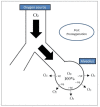Apneic Oxygenation: A Summarized Review and Stepwise Approach
- PMID: 38249244
- PMCID: PMC10799750
- DOI: 10.7759/cureus.50916
Apneic Oxygenation: A Summarized Review and Stepwise Approach
Abstract
Apneic oxygenation is a technique used during airway management procedures to maintain oxygenation and prevent desaturation during a lack of ventilation. Despite its importance, there is a lack of comprehensive information on how to achieve effective apneic oxygenation, leading to misunderstandings and suboptimal utilization of this technique. Apneic oxygenation involves several key steps. Firstly, patient selection is crucial, considering factors such as anticipated difficulty with airway management, reduced functional residual capacity, increased oxygen consumption, and medical conditions associated with impaired oxygenation. Secondly, adequate preoxygenation is essential to optimize oxygen reserves before the onset of apnea, utilizing methods like non-rebreather oxygen masks or specific breathing techniques. Thirdly, maintaining airway patency through techniques such as jaw thrust or nasopharyngeal airway placement allows for unobstructed airflow during the apneic period. Lastly, the selection of the appropriate oxygen delivery method, such as high-flow nasal oxygen or nasal cannula, depends on the patient's existing respiratory support. Despite the growing body of literature on apneic oxygenation, current review articles often lack a stepwise approach for its proper execution. This knowledge gap contributes to the misunderstanding and underutilization of this important tool during intubation and airway management. In conclusion, apneic oxygenation is a valuable technique for maintaining oxygenation during periods of apnea. However, the lack of comprehensive information and stepwise guidance in the current literature hinders its optimal utilization. Clear guidelines and educational resources should be developed to address this knowledge gap and ensure the safe and effective implementation of apneic oxygenation. By following a stepwise approach that includes patient selection, adequate preoxygenation, airway patency, and appropriate oxygen delivery, healthcare providers can enhance patient outcomes and minimize the risk of desaturation during airway management procedures.
Keywords: airway intubation; apneic oxygenation; can't intubate can't ventilate; desaturation; difficult airway management; emergency endotracheal intubation; high flow nasal cannula (hfnc); laryngeal pathology; oxygen therapy; stepwise approach.
Copyright © 2023, Fayed et al.
Conflict of interest statement
The authors have declared that no competing interests exist.
Figures





References
-
- Apneic oxygenation in man. Frumin MJ, Epstein RM, Cohen G. Anesthesiology. 1959;20:789–798. - PubMed
-
- Pulmonary uptake of oxygen, acid-base metabolism, and circulation during prolonged apnoea. Holmdahl MH. https://pubmed.ncbi.nlm.nih.gov/13326155/ Acta Chir Scand Suppl. 1956;212:1–128. - PubMed
-
- Diffusion in anaesthesia. Sleath GW, Jenkins LC, Graves HB. Can Anaesth Soc J. 1963;10:72–82. - PubMed
-
- Apneic oxygenation during prolonged laryngoscopy in obese patients: a randomized, controlled trial of nasal oxygen administration. Ramachandran SK, Cosnowski A, Shanks A, Turner CR. J Clin Anesth. 2010;22:164–168. - PubMed
Publication types
LinkOut - more resources
Full Text Sources
Miscellaneous
